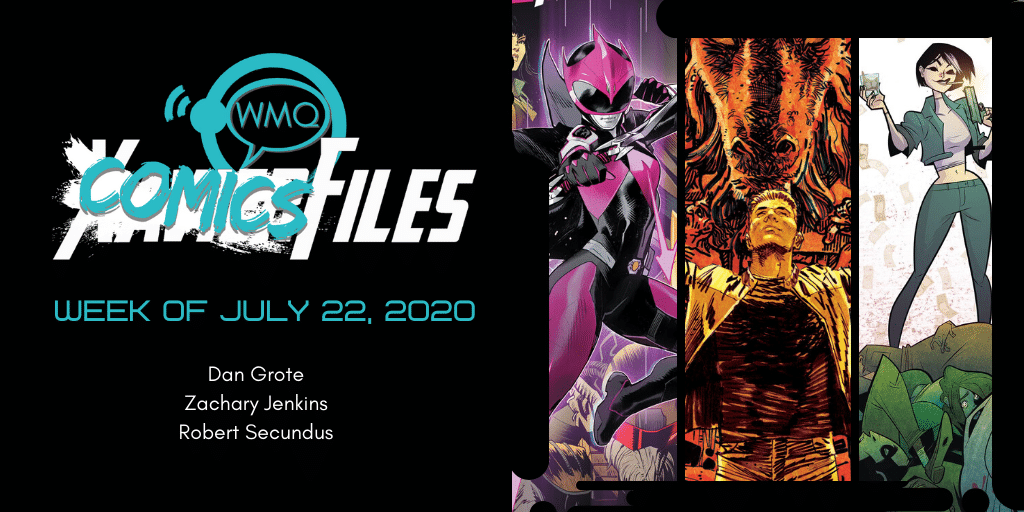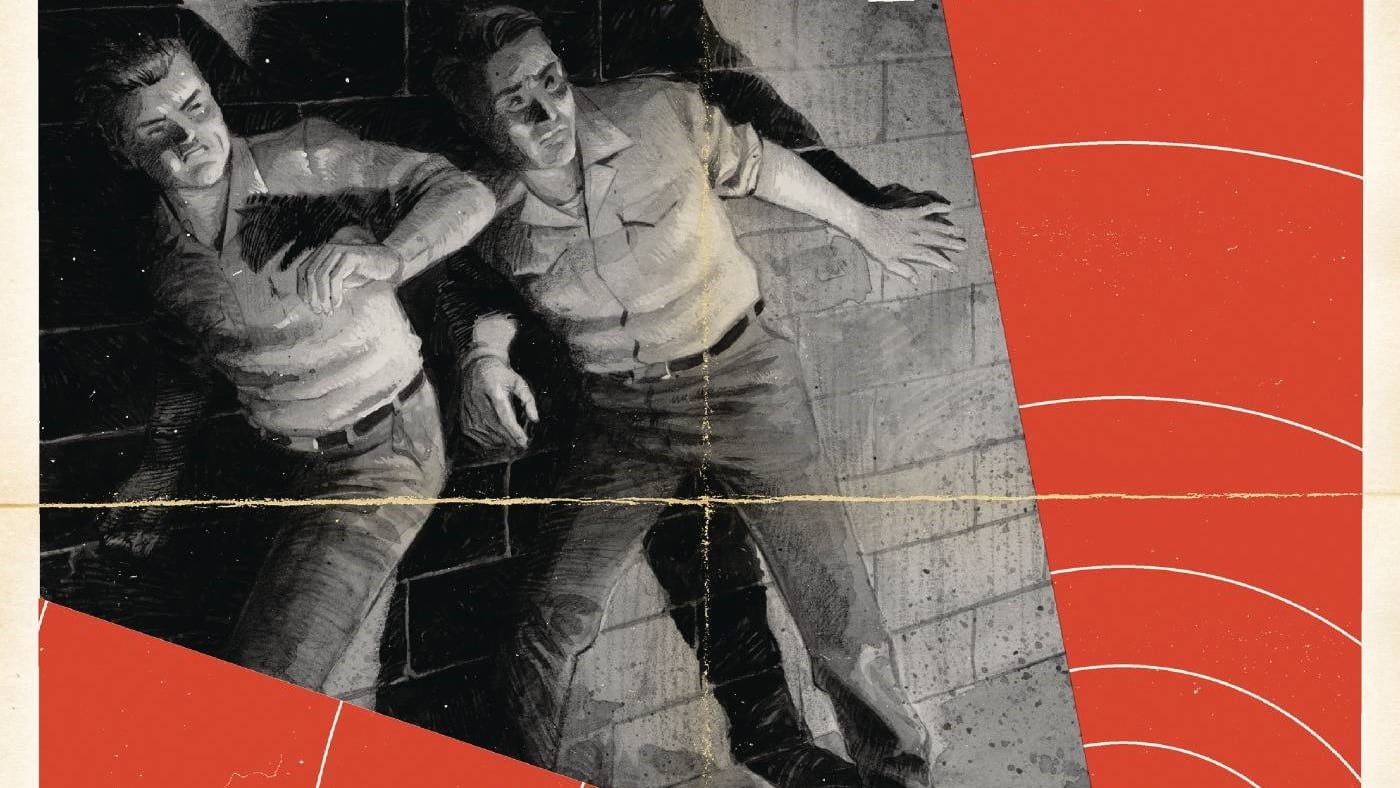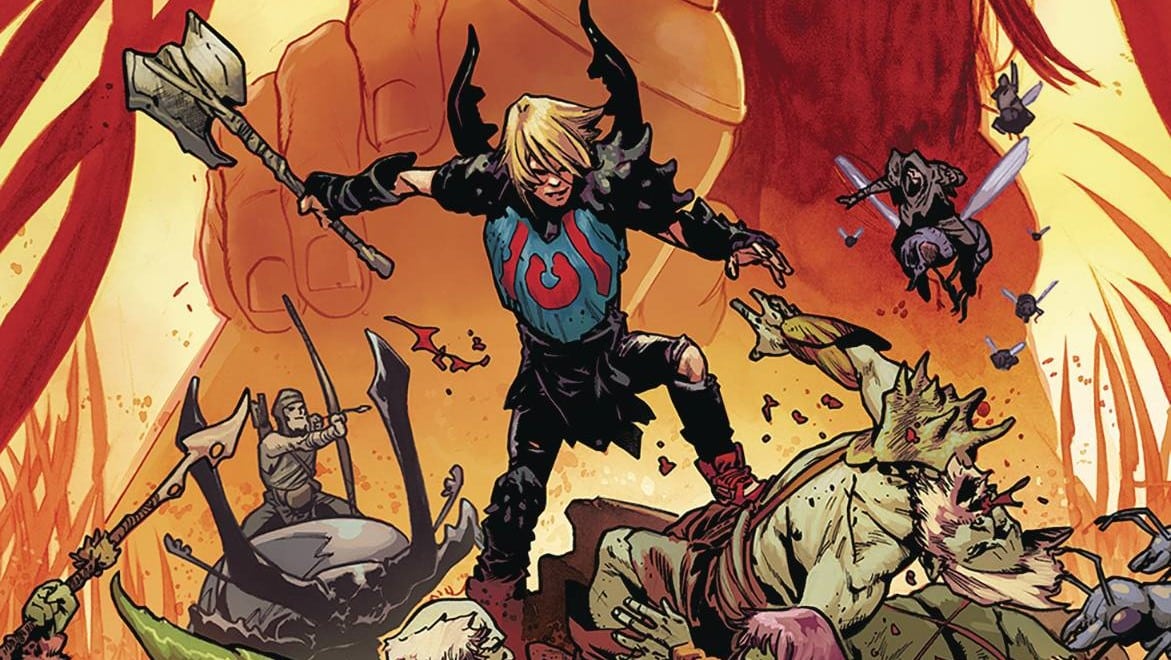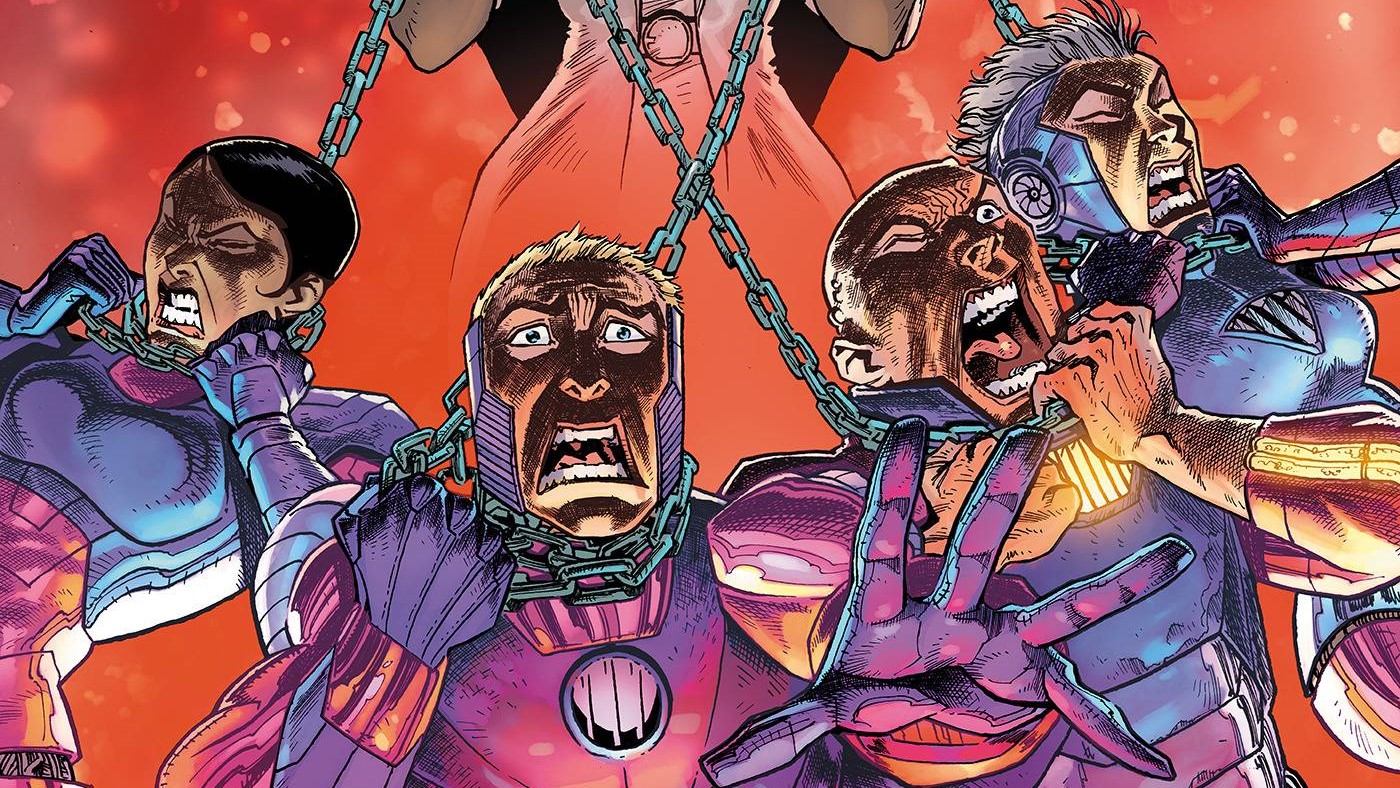Here comes the BOOM! … Studios. This week in our indie review roundup, Dan Grote cracks open Image’s Chu #1, Zachary Jenkins looks at Power Rangers: Ranger Slayer #1 and Robert Secundus continues his exploration of the BOOM!-fyverse (TM) with Angel & Spike #12.
Chu #1
Writer/Letterer: John Layman, Artist: Dan Boultwood, Publisher: Image

Tony Chu is a cibopath, able to get psychic impressions from what he eats. Saffron Chu is a cibopars, able to learn secrets from who she eats with. Tony is a cop. Saffron is a criminal. They are brother and sister, and they are on a collision course.
Don’t worry, that’s not a spoiler. That’s the solicit text for Chu #1, a prequel series of a sort to Image’s 2009-16 series Chew by John Layman and Rob Guillory.
Also, not everything revealed in the solicit is in the comic.
We learn that Saffron Chu is a Cibopars, but we don’t actually learn what that means. We know she knows stuff, in a Layla Miller sort of way, but we’re not clear how she came by that knowledge.
Meanwhile, big brother Tony gets his standard page explaining in detail how his powers work, in that classic Layman lettering, but with a new Dan Boultwood coat of paint.
Layman is going back to his greatest hit on the heels of the cancellation of his previous Image series, Outer Darkness, which ended with a three-part Chew crossover. In this time of reduced publishing lines and pandemic-fueled uncertainty, there’s no shame in betting on a sure thing, especially when you’ve got other work out there – specifically his previously announced IDW series Bermuda – that’s been pushed all the way out to next year.
But while the story and the players in Chu are familiar, Boultwood is not a Guillory copycat. His style is more angular, but also much cruder. I’d be interested in seeing his art two years from now, after he’s gotten some more sequential experience under his belt. I bet it’ll really be something, much like how Guillory’s art has evolved over the years.
Sigh … I miss Farmhand.
Nevertheless, it’s a fun story. The first half is a classic heist, mixed with Layman’s seemingly endless capacity to invent new food crimes. The second half explains how and when Saffron fits into the wider Chew world.
That said, the cliffhanger reveal that Saffron and Tony are siblings was already in the solicit, so as last pages go, it’s not an all-timer.
Full disclosure: I love Chew. It’s one of the series that drew me back into regular comics reading. As a fan of that series, I can confidently say Chu #1 is a flawed comic, but still a fun one. Given time, it will find its footing. Given the current state of comics and the world, I hope that time isn’t a luxury.
Power Rangers: Ranger Slayer #1
Writer: Ryan Parrott, Artist: Dan Mora, Colorist: Raul Angulo, Letterer: Ed Dukeshire, Publisher: BOOM Studios

BOOM! Studios’ Power Rangers franchise follows a long, prestigious lineage in comics. It has done for the teenagers with attitude what Larry Hama did for G.I. Joe or what Bob Budiansky did for Transformers: It took a franchise built on the concept of selling toys to children and added the depth and nuance we all wanted there to be when we were 5.
In fact, the comics have evolved past their origins and developed a mythology larger than their tokusatsu beginnings. The line is barreling toward a relaunch, and Power Rangers: Ranger Slayer #1 looks to tie up some of the most interesting loose ends.
The Power Rangers were always a superhero franchise, just one that took more inspiration from Kamen Rider than Batman. This was a creative boon as American kids hadn’t seen those tropes in the past. It felt fresh and exciting. Within the comics, original series writer Kyle Higgins added back some of those Western elements, like dark futures and universe-shattering crossovers. Ironically enough, this reversal helped Mighty Morphin Power Rangers feel like something new after 20-plus years of Japanese hero beats.
As they close out this first saga, writer Ryan Parrott and artist Dan Mora return to one of the characters that best blended the two aesthetics, the Ranger Slayer. On one hand, she is the “sixth ranger,” a special character with a unique design who starts as an antagonist to the Rangers but becomes a strong ally (See Parrott’s Go! Go! Power Rangers). On the other, she’s the dark mirror of Kimberly Hart, the classic Pink Ranger, from a bad future, come back to help prevent it. She’s Cable and Tommy Oliver combined in a beautiful synthesis of heroes from around the world. She’s an idea that doesn’t happen anywhere except a comic, which makes her a great spotlight for this book.
Power Rangers: Ranger Slayer #1 isn’t a point to jump on. It wraps up the world of The Coinless in a nice bow, while opening up opportunities to return later. Parrott gives everyone in his cast a moment to shine, adding depth and purpose to even his minor characters. It’s a wonderful showcase for Mora, who mixes classic Ranger design elements within the lens of a massive finale war. The action is clean and exciting, exactly what one would expect from one of the most underrated artists in comics. This is what folks always dreamed Power Rangers comics could be, with both sides of that equation perfectly balanced into a satisfying world.
Angel & Spike #12
Writer: Bryan Edward Hill, Artist: Gleb Melnikov, Colorist: Roman Titov, Letterer: Ed Dukeshire, Publisher: BOOM Studios

My first BOOM!-fyverse comic was Willow #1, which I discussed here a few weeks back. I was a bit confused about a few things in that comic: how the overarching story was being paced, and who that story was for. Still, it was an extremely enjoyable read, enjoyable enough to spark a desire for more Buffy & Angel in my life for the first time in a long while.
So I started at the beginning. I’ve read Buffy through the end of the Hellmouth crossover, and Angel, now Angel & Spike, from the beginning to this issue.
I’m hooked now as a reader going forward. Both series capture the feel and the voice of the original in ways unlike any of the comic continuations or imitations that came before. Both usefully update and expand the cast and scope of the originals. Each has added a central character: Kendra’s teen Watcher in Robin, and Angel’s link to the Powers That Be in Lilith, who is THE Lilith of legend, and a much better representation of said legend than we normally see in comics. While Robin complicates the dynamics of Buffy, Lilith streamlines the plot of Angel. Angel doesn’t need to go hunting for oracles, prophets and scrolls to figure out what comes next, or what TPTB desire. Lilith just shows up and tells him.
I don’t think it’s a coincidence either that both characters are people of color, reflections in some way of the main character in each series, and characters deeply tied to the world’s mythology. I think both point toward who this series is for: younger fans of the original who aren’t completely satisfied with the original. Neither would exist if this reboot was purely nostalgic (an existing character would have been shifted to fulfill each of these aspects), but both, I think, are written with fans in mind. Buffy finally gets a love interest that isn’t completely destructive; her experience as a secret Slayer in high school is mirrored by a secret Watcher; we get to see a character only mentioned in the original. Angel gets to interact directly with higher powers; his struggle with both his past sins and the complexities of his fate are magnified immensely in Lilith’s own position; and we get to see a character close to the origins of evil in this monstrous universe.
I’ve been speaking generally about both series, but it was Angel & Spike #12 in particular this week that finally, I think, cracked open the structure of these stories for me. This is the third arc of this comic, and the first in which Angel Investigations has begun to operate, with the cast of Angel, Spike, Gunn and Fred assembled. Lorn is on the edges of the narrative; Kate, unfortunately, has joined the fray; and Wolfram and Hart are standing in opposition. The only major pieces missing, Wesley and Cordelia, are those that rely on significant time passing in Buffy. In this story, they confront a typical Monster of the Week-type enemy: a demon that can possess/infect people and cause them to self-immolate. With the whole available cast in play, we get to see them settle into the old dynamics we loved.
And then Fred, as she does in the final episodes of the original series, becomes the vessel of a powerful entity. The cast is broken, the dynamic changed, within the same story that it was finally solidified. This mirrors Buffy, in which the opening issues zoom through time to get us to a place where the core cast is all Season 2 or 3 friendly-like, only to break the dynamic it’s rushed toward by killing Xander (twice). There, Xander fell to what felt like another Monster of the Week episode, as he sacrificed himself to stop a spell of Magical Toxic Masculinity. Fred’s sacrifice and rebirth and Baphomet showed what I think is the pattern of these series: rush to assemble something familiar and immediately discard it. I’d also thought it was a waste to toss off a core cast member in a MotW, but “Ring of Fire” showed me something else, that I was thinking about these series in terms that no longer applied. There is no such thing as a Monster of the Week in the BOOM!-fyverse. Every arc moves the story forward; every monster is a threat that might kill our heroes or conquer the world.
I think that’s probably an inspired way of solving a key problem that arises when you move a TV serial to a comic serial: time. The reading time involved in reading one year of (most modern) comics equates to the watching time of only a few episodes of (most) television. So you either have to be content with one year of published comics equating to a much smaller snippet of your characters’ lives, or you have to ensure that each issue published accelerates the timeline. But it wouldn’t feel like the originals either if those weird, quirky monsters that often spoke in some over-the-top way to the problems in our society were just discarded. The first arc of Angel sees him fighting a demon that is, essentially, a Twitter troll, and it’s great. That aforementioned Magical Spell of Toxic Masculinity feels exactly like the kind of enemy we’d expect to see on the show, were it on today. So don’t discard those; instead, make sure any arc featuring those is also a status-quo shifting, season-finale type arc that moves everything vastly forward.
It’s an inspired choice, but not one I think I like. The plot of Buffy and Angel was always the least important thing. What people loved was spending time with these characters, their jokes, their conversations, their heartbreaks, their joys, their pains. In the later years, huge status quo shifts, like the death of Buffy or the acquisition of Wolfram & Hart, mattered quite a bit, but only because such shifts altered the dynamic of how we, again, spent time with those characters. It mattered because we established a baseline.
When I turn to that last page of Angel & Spike #12, it’s still a powerful moment to see Winnifred Burkle, one of my favorite characters in fiction, as Baphomet. But it’s only powerful because that moment contrasts with the Burkles of my memory, with both Fred and Illyria. I haven’t seen enough of this Fred for it to matter that this Fred is gone, and her companions have lost a coworker who helped with a couple of missions, not a years-long friend.
I think the approach we’re seeing loses so much of what made Buffy and Angel special. I think decompression rather than acceleration would better serve these characters and build a foundation for years of new stories with them. And yet: I enjoyed every page of Angel & Spike #12. I’ve enjoyed every page of the series, and of every other series in this universe.








